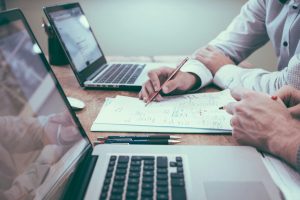The pharmaceutical trade between nations involves complex financial transactions, and sometimes, businesses face the challenge of unpaid bills. Resolving these debts in the pharmaceutical trade with Canada requires a nuanced understanding of the debt collection process, evaluation of debt recovery viability, decision-making strategies, financial considerations, and effective communication techniques. This article delves into these aspects to provide a comprehensive guide for companies dealing with unpaid pharmaceutical bills in Canada.
Key Takeaways
- The pharmaceutical debt collection process is structured into three phases, with initial efforts escalating to legal action if necessary.
- Debt recovery viability is assessed through a thorough investigation of debtor assets and the likelihood of successful collection.
- Decision-making regarding unpaid bills involves evaluating legal action versus alternative methods, considering financial implications.
- Financial considerations include understanding upfront legal costs, collection rates based on claim volume and age, and contingency fees.
- Effective communication with debtors is crucial, utilizing multiple contact methods and persistent collection attempts to recover debts.
Understanding the Pharmaceutical Trade Debt Collection Process
Phase One: Initial Collection Efforts
Within the first 24 hours of initiating Phase One, we spring into action. Our primary goal is to engage with the debtor and establish a line of communication. We send out the initial letter, which serves as a formal notice of the outstanding debt. Concurrently, we employ skip-tracing to gather the most up-to-date financial and contact information available.
Our approach is persistent yet professional. We make daily attempts to reach the debtor through phone calls, emails, text messages, and faxes. This intensive contact strategy is designed to yield a resolution swiftly. If these efforts do not produce the desired outcome within the first 30 to 60 days, we are prepared to escalate the matter to Phase Two, involving our network of affiliated attorneys.
The success of our initial collection efforts hinges on our ability to act quickly and decisively. We understand that time is of the essence, and our team is dedicated to maximizing recovery efforts from the outset.
Here’s a snapshot of our collection rates based on the number of claims submitted in the first week:
| Claims Submitted | Accounts < 1 Year | Accounts > 1 Year | Accounts < $1000 | Attorney-Placed Accounts |
|---|---|---|---|---|
| 1-9 | 30% | 40% | 50% | 50% |
| 10+ | 27% | 35% | 40% | 50% |
Debt collection rates are determined by the number of claims submitted in the first week, varying based on account age, amount collected, and attorney involvement. Trade debt recovery complexities are discussed in various industries.
Phase Two: Escalation to Affiliated Attorneys
Once we escalate the matter to our network of affiliated attorneys, we’re stepping up the pressure. Our attorneys swing into action, drafting demand letters and making calls. They’re persistent, they’re professional, and they’re on your side. Here’s what happens:
- The attorney sends a series of letters on law firm letterhead, insisting on payment.
- Phone calls follow, adding a personal touch to the demand.
- If the debtor remains unresponsive, we prepare you for the potential next steps.
We’re transparent about the journey ahead. If the debtor’s silence continues, we’ll discuss the recommendations and costs associated with Phase Three. We’re in this together, and we’ll guide you through the decision-making process.
Our goal is to recover what’s owed to you efficiently and ethically. We understand the nuances of the debt recovery process and tailor our approach to each unique case. With our expertise, we aim to maximize your chances of recovery while minimizing unnecessary expenses.
Phase Three: Litigation and Closure Recommendations
When we reach Phase Three, we’re at a critical juncture. We’ve exhausted initial collection efforts and our affiliated attorneys have escalated the matter. Now, we must decide: litigate or close the case. If the debt recovery seems unlikely, we’ll advise to close the case, sparing you further costs.
Should you opt for litigation, be prepared for upfront legal costs. These typically range from $600 to $700, depending on the debtor’s jurisdiction. Upon payment, our attorney will file a lawsuit on your behalf. If unsuccessful, the case closes, and you owe us nothing further.
Our commitment is clear: pursue recovery or recommend closure based on solid evidence and financial prudence.
Our rates are competitive, structured to align with your claim volume and age. Here’s a snapshot:
- For 1-9 claims, rates vary from 30% to 50% of the amount collected, based on the age and size of the account.
- For 10 or more claims, the rates are slightly reduced, reflecting our volume discount.
Remember, the options for legal action in Phase Three are clear: proceed with litigation by paying upfront costs or withdraw the claim with no fees. We cover debt recovery across various industries, including chemical, food, telecom, and environmental tech.
Evaluating the Viability of Debt Recovery
Investigation of Debtor’s Assets
We dive deep into the debtor’s financial landscape, leaving no stone unturned. Our goal is to paint a clear picture of the debtor’s ability to pay. We assess assets, liabilities, and overall financial health to determine the feasibility of debt recovery. This step is crucial; it informs our strategy moving forward.
Skip-tracing is a key tool in our arsenal. It helps us uncover hidden assets and obtain the most current financial information. We’re thorough because we know the success of our collection efforts hinges on accurate data.
Here’s a snapshot of our initial asset investigation process:
- Review of debtor’s financial statements
- Analysis of property and asset ownership
- Examination of business operations and revenue streams
Our experience tells us that a well-conducted asset investigation can make the difference between successful recovery and a dead end. It’s the bedrock upon which we build our collection strategy.
Assessment of Recovery Likelihood
We assess the likelihood of recovery by meticulously examining the debtor’s assets and the surrounding facts of the case. If the odds are not in our favor, we advise case closure, ensuring you owe nothing for such outcomes.
Recovery is not a shot in the dark; it’s a calculated decision. Here’s how we break it down:
- Investigation of debtor’s financial standing
- Analysis of claim age and amount
- Evaluation of previous collection efforts
We stand by our commitment to provide a clear path forward, whether it leads to litigation or case closure.
When the potential for recovery is promising, we gear up for litigation, with a clear understanding of the associated costs. Our competitive rates are tailored to the volume and age of claims, ensuring you’re informed every step of the way.
Recommendations for Case Closure
When we reach the crossroads of case closure, our recommendations hinge on the viability of recovery. If the debtor’s assets and case facts suggest low recovery chances, we advise to close the case. This decision incurs no fees from us or our affiliated attorneys.
Should litigation seem promising, you face a choice. Opting out means no cost; you can retract the claim or let us continue standard collection efforts. Choosing litigation requires covering upfront legal costs, typically $600-$700. If litigation doesn’t yield results, the case closes, free of any further obligation to us.
Our rates are competitive, structured to the claim volume and age:
- For 1-9 claims, rates range from 30% to 50% of the amount collected.
- For 10+ claims, rates decrease, with a minimum of 27% for newer accounts.
We strive for swift resolution in Phase One, but when necessary, we’re prepared for the subsequent phases, ensuring a thorough investigation and strategic collection activities.
Decision Making in the Face of Unpaid Pharmaceutical Bills
Choosing to Pursue Legal Action
When we face unpaid pharmaceutical bills, the decision to pursue legal action is not taken lightly. We must weigh the potential benefits against the costs and risks involved. If we choose to litigate, we’re committing to upfront legal costs, which can range from $600 to $700, depending on the jurisdiction. These costs cover court fees, filing fees, and other related expenses.
Litigation is a serious step, and we must be prepared for all outcomes. If our efforts to collect through legal means are unsuccessful, we can close the case without additional charges from our firm or affiliated attorneys. However, if we decide against legal action, we have the option to withdraw the claim or continue standard collection activities.
Our strategies for resolving these issues include:
- Conducting thorough credit checks
- Establishing clear contractual terms
- Maintaining effective communication
- Engaging in negotiation
- Considering legal actions
- Exploring alternative dispute resolution
We must always be strategic and consider all available options to minimize risks and recover debts efficiently.
Understanding the Financial Implications
When we face the decision to pursue legal action for unpaid pharmaceutical bills with Canada, we must weigh the financial implications carefully. The cost of litigation is not just a number; it’s a commitment to a process that may extend over months or even years. We’re looking at upfront legal costs, including court fees and filing charges, which typically range from $600 to $700. These expenses are just the tip of the iceberg.
Recovery is not guaranteed, and the financial burden can increase if the case drags on. We must consider the collection rates, which vary based on the age and volume of claims. For instance, accounts under one year may have a 30% collection rate, while older accounts could see up to 40%. If an attorney is involved, the rate can jump to 50% of the amount collected.
- Initial upfront legal costs
- Varying collection rates based on claim details
- Potential increase in costs over time
We must be strategic in our recovery steps, including a thorough investigation and systematic implementation of a recovery system. The choice to litigate should be measured against the potential financial strain and the likelihood of successful debt recovery.
Ultimately, the decision to proceed with legal action hinges on a careful assessment of these financial implications. We must balance the desire to recover debts with the practicality of the costs involved.
Alternatives to Litigation
When legal action seems daunting, we’ve got other cards to play. Negotiation is our first alternative, aiming to reach a settlement that satisfies both parties. We’ll leverage our expertise to broker a deal, often resulting in faster resolution and reduced costs.
Mediation offers a neutral ground, with a third-party mediator helping to untangle the dispute. It’s less formal than court and can preserve business relationships.
Here’s a quick rundown of our non-litigation approaches:
- Direct negotiation to settle out of court
- Mediation with a neutral third party
- Payment plans to ease the debtor’s financial burden
- Assigning the debt to a collection agency
We understand the nuances of the pharmaceutical trade and are adept at resolving unpaid bills without resorting to the courtroom. Our strategies are designed to maintain business continuity while recovering what’s owed to you.
Financial Considerations and Collection Rates
Upfront Legal Costs and Fees
When we decide to take legal action, understanding the financial commitment is crucial. Upfront legal costs are a reality we cannot ignore. These costs typically include court fees, filing fees, and may vary depending on the debtor’s jurisdiction. We’re looking at an average range of $600 to $700 for these initial expenses.
It’s essential to note that if we choose not to pursue litigation after the initial assessment, there are no fees owed to our firm or affiliated attorneys.
Our commitment to transparency means we lay out all potential costs from the get-go. Here’s a quick breakdown of collection rates based on claim volume:
- For 1-9 claims: 30% to 50% of the amount collected
- For 10+ claims: Collection rates range from 27% to 50%
Remember, these rates are competitive within the USA-Canada pharmaceutical trade, and we only charge if we successfully recover your funds.
Collection Rates Based on Claim Volume and Age
We understand that the volume and age of claims significantly influence collection rates. The older the debt, the steeper the fee—a reflection of the increased difficulty in recovering funds as time passes. Here’s a snapshot of our competitive rates:
| Claims Volume | Accounts < 1 Year | Accounts > 1 Year | Accounts < $1000 | Attorney-Placed |
|---|---|---|---|---|
| 1-9 | 30% | 40% | 50% | 50% |
| 10+ | 27% | 35% | 40% | 50% |
We strive to keep our rates fair and aligned with industry standards, ensuring you get the best possible return on your collection efforts.
Remember, the sooner we act on a delinquent account, the higher the likelihood of successful recovery. It’s a balancing act between immediate action and cost-effective strategies.
Contingency Fees for Attorney-Placed Accounts
When we place accounts with attorneys, a contingency fee structure is often the most practical approach. We only get paid if you get paid – it’s that simple. The standard fee is a flat 50% of the amount collected, aligning our interests with yours. This means our efforts are directly tied to the successful recovery of your funds.
Contingency fees ensure that you’re not out-of-pocket unless there’s a positive outcome. Here’s a quick breakdown of our rates for attorney-placed accounts:
- Accounts under 1 year in age: 50% of the amount collected
- Accounts over 1 year in age: 50% of the amount collected
- Accounts under $1000.00: 50% of the amount collected
Remember, our goal is to resolve your unpaid bills efficiently. We employ various communication tactics, including multiple channels, to maximize the chances of debt resolution.
Strategies for Effective Communication with Debtors
Utilizing Multiple Contact Methods
We embrace a multi-faceted approach to reach out to debtors. Diverse contact methods are key to our success. We don’t just rely on phone calls; we deploy emails, texts, faxes, and letters to ensure our message is heard. Each method is tailored to the debtor’s preferences and response patterns.
Persistence pays off. We follow a structured timeline for contact attempts, ensuring no debtor slips through the cracks. Here’s a snapshot of our contact strategy:
- Initial contact within 24 hours of account placement
- Daily attempts for the first 30 to 60 days
- Escalation to affiliated attorneys if necessary
We’re committed to adapting our strategies to maximize recovery chances. Our team’s expertise in skip tracing and legal actions bolsters our ability to recover debts effectively.
By covering all bases, we leave no stone unturned in the pursuit of what’s owed.
The Role of Skip-Tracing in Debt Recovery
We harness the power of skip-tracing to locate debtors who’ve gone off the radar. It’s a crucial step in the recovery process. Finding the debtor is half the battle won.
Our team employs advanced tools to track down elusive debtors, ensuring no stone is left unturned. Here’s how we streamline our skip-tracing efforts:
- Comprehensive database searches
- Analysis of public records
- Employment of investigative techniques
We don’t just look for debtors; we aim to understand their financial landscape for a strategic approach to recovery.
Once we’ve located the debtor, we’re better positioned to initiate meaningful dialogue and negotiate payment. It’s about being one step ahead in the debt recovery game.
Frequency and Persistence in Collection Attempts
We understand that persistence is key in debt recovery. Daily attempts to reach out to debtors are crucial in the first 30 to 60 days. Our proactive debt collection service emphasizes relentless efforts to resolve debts through communication, investigation, and legal escalation if necessary. We focus on maximizing recovery chances before considering legal actions.
Our clear and persistent communication strategies are designed to break through the noise and ensure that our message is heard.
We employ a variety of contact methods, including phone calls, emails, text messages, and faxes. This multi-channel approach increases the likelihood of a response and a resolution. Here’s a snapshot of our initial collection efforts:
- First of four letters sent via US Mail within 24 hours of placing an account.
- Skip-tracing and investigation to obtain the best financial and contact information.
- Daily contact attempts using multiple communication channels.
If these attempts do not yield results, we escalate the matter to our affiliated attorneys, who continue the pursuit with the same level of frequency and determination.
Mastering the art of communication with debtors is crucial for successful debt recovery. At Debt Collectors International, we specialize in dispute resolution, skip tracing, and judgment enforcement to ensure you get the results you need. Our experienced team is ready to assist you with tailored solutions across various industries. Don’t let overdue accounts disrupt your cash flow. Visit our website to learn more about our strategies for effective communication with debtors and take the first step towards reclaiming your funds.
Frequently Asked Questions
What happens during Phase Three if debt recovery is deemed unlikely?
If after a thorough investigation it’s determined that recovery is not likely, we will recommend closure of the case. You will owe nothing to our firm or our affiliated attorney for these results.
What are the upfront legal costs if I decide to proceed with litigation?
If you decide to proceed with legal action, you will be required to pay upfront legal costs such as court costs and filing fees, which typically range from $600.00 to $700.00, depending on the debtor’s jurisdiction.
What are the collection rates for accounts under 1 year in age?
For 1 through 9 claims, the rate is 30% of the amount collected. For 10 or more claims, the rate is 27% of the amount collected.
How does the collection process begin in Phase One?
Within 24 hours of placing an account, letters are sent, cases are skip-traced, and our collector attempts to contact the debtor using multiple methods. Daily attempts are made for the first 30 to 60 days before moving to Phase Two.
What actions are taken when a case is escalated to Phase Two?
The case is sent to a local attorney within our network who will draft letters and attempt to contact the debtor via telephone to demand payment.
If litigation fails, what financial obligations do I have towards your firm or the affiliated attorney?
If attempts to collect via litigation fail, the case will be closed and you will owe nothing to our firm or our affiliated attorney.





